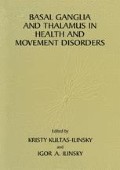Abstract
Knowledge of the organization and connections of the basal ganglia has greatly advanced in recent years, and, concurrently, understanding and neurosurgical treatment of movement disorders of basal ganglia origin, primarily Parkinson’s disease, have significantly improved. Models of basal ganglia-thalamo-cortical circuitry have been developed to account for both normal function and motor disorders (DeLong, 1990), but these rely primarily on hodological data extrapolated from experimental animals. Direct investigations of basal ganglia output connections in the human brain are rare and often impeded by lesions encroaching upon the capsule, thus rendering interpretations of the origin of degeneration difficult (Martinez, 1961; Beck and Mignami, 1968; Rye et al., 1995). Moreover, these studies were conducted in the brains of parkinsonian patients already presenting pathological features due to the disease. The present study on the distribution of axonal degeneration resulting from lesions confined to the striatum and pallidum provides additional significant information on the pallidofugal pathways in man, especially on those from the external segment, which may have particular relevance in the physiopathology of movement disorders.
Access this chapter
Tax calculation will be finalised at checkout
Purchases are for personal use only
Preview
Unable to display preview. Download preview PDF.
References
Aldheid, G.F., Heimer, L., and Switzer, R.C., 1990, Basal ganglia, in:The Human Nervous System,G.Paxinos, ed., Academic Press Inc., San Diego.
Asanuma, C., 1994, GABAergic and pallidal terminals in the thalamic reticular nucleus of squirrel monkeys,Exp. Brain Res.101:439.
Beck, E., and Bignami, A., 1968, Some neuro-anatomical observations in cases with stereotactic lesions for the relief of parkinsonism,Brain, 91:589.
DeLong, M.R., 1990, Primate models of movement disorders of the basal ganglia,Trends Neurosci.13:281.
Hazrati, L.-N., and Parent, A., 1991, Projection from the external pallidum to the reticular thalamic nucleus in the squirrel monkey,Brain Res.550:142.
Lynd-Balta, E., and Haber, S.N., 1994, Primate striatonigral projections: A comparison of the sensorimotor-related striatum and the ventral striatum,J. Comp. NeuroL345:562.
Martinez, A., 1961, Fiber connections of the globus pallidus in man,J. Comp. Neurol.117:37.
Miklossy, J., Clarke, S., and Van der Loos, H., 1991, The long distance effects of brain lesions: Visualization of axonal pathways and their terminations in the human brain by the Nauta method,J. Neuropathol.Expt. Neurol.50:595.
Morel, A., Magnin, M., and Jeanmonod, D., 1997, Multiarchitectonic and sterreotactic atlas of the human thalamus,J. Comp. Neurol.387:588.
Nauta, W.J.H., and Mehler, W.R., 1966, Projections of the lentiform nucleus in the monkey,Brain Res.1:3.
Parent, A., and Hazrati, L.-N., 1995, Functional anatomy of the basal ganglia. II. The place of the subthalamic nucleus and external pallidum in basal ganglia circuitry,Brain Res. Rev.20:128.
Rye, D.B., Vitek, J., Bakay, R.A.E., Kaneoke, Y., Hashimoto, T., Turner, R., Mirra, S., and DeLong, M.,1995, Termination of pallidofugal pathways in man,Soc. Neurosci. Abstr.21:676.
Sidibé, M., Bevan, M.D., Bolam, J.P., and Smith, Y., 1997, Efferent connections of the internal globus pallidus in the squirrel monkey: 1. Topography and synaptic organization of the pallidothalamic projection,J. Comp. Neurol.382:323.
Author information
Authors and Affiliations
Editor information
Editors and Affiliations
Rights and permissions
Copyright information
© 2001 Springer Science+Business Media New York
About this chapter
Cite this chapter
Morel, A., Magnin, M., Jeanmonod, D. (2001). Efferent Connections of the Human Striatum and Pallidum: A Nauta Degeneration Study. In: Kultas-Ilinsky, K., Ilinsky, I.A. (eds) Basal Ganglia and Thalamus in Health and Movement Disorders. Springer, Boston, MA. https://doi.org/10.1007/978-1-4615-1235-6_5
Download citation
DOI: https://doi.org/10.1007/978-1-4615-1235-6_5
Publisher Name: Springer, Boston, MA
Print ISBN: 978-1-4613-5454-3
Online ISBN: 978-1-4615-1235-6
eBook Packages: Springer Book Archive

